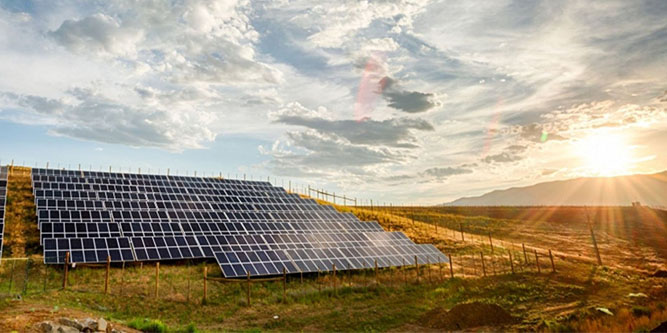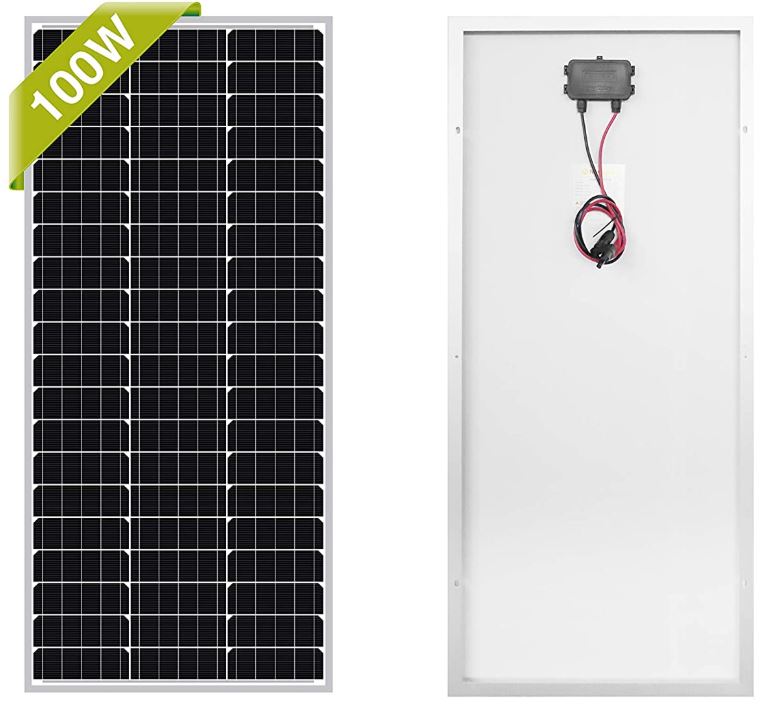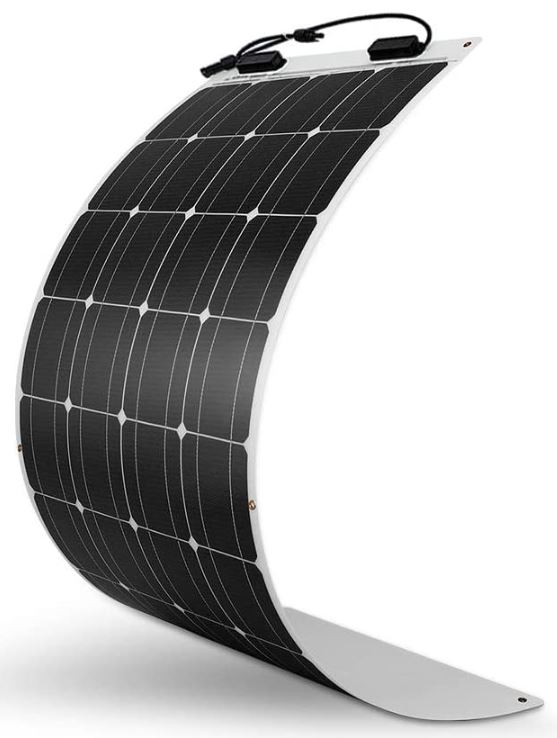Solar panels used to be an expensive investment, used for off-grid cabins or other applications where on-grid power wasn’t available. But nowadays, solar panels can be used to power everything from floodlights to security cameras. They’re now so affordable that just about anybody can get in the game. Even better, several states also give you a tax deduction on your solar panel purchase.
There are a few ways to install a solar system. If you’re off the grid, the best option is simply just to use batteries for storage. This way, you can still get electricity at night. If you’re on the grid, a battery is still a viable option. However, you can get a better value by using a grid-tied inverter to tie your solar panels to the grid. This way, the power company will pay you for any excess power you produce. So not only will you save on batteries, but you can actually turn a small profit!
Solar system installation can be a bit tricky. Unless you’re very comfortable with electronics, it might be better to hire a professional. You need to choose compatible cables, the right controller, and, if needed, the right batteries. That said, most consumer-scale solar systems are going to use a 100-watt, 12-volt panel. To be fair, there are other wattages available. But 100-watt panels are the most scalable. You can install a single panel on your RV, or a large array on your roof or lawn. Best of all, if one of the panels get damaged, you’re not out a huge sum of money. With a huge panel, if any part of it gets damaged, you can be looking at a major expense.
Today, we’ll be looking at three different monocrystalline 100-watt, 12-volt solar panels. First, we’ll be reviewing the Renogy 100 Watt 12 Volt Monocrystalline Solar Panel. This is a pricier panel, but it’s exceptionally sturdy and weather-resistant, ideal for challenging conditions. Next, we’ll take a look at the Newpowa 100 Watt Monocrystalline 12v Solar Panel. This is a more affordable option, but it will require some additional weatherproofing for permanent installation. Finally, we’ll review the Renogy 100 Watt 12 Volt Extremely Flexible Monocrystalline Solar Panel. As the name implies, this panel is lightweight and flexible, designed for installation on irregular surfaces. Afterwards, we’ll sum up what we’ve learned, and render a final verdict. Let’s get started!
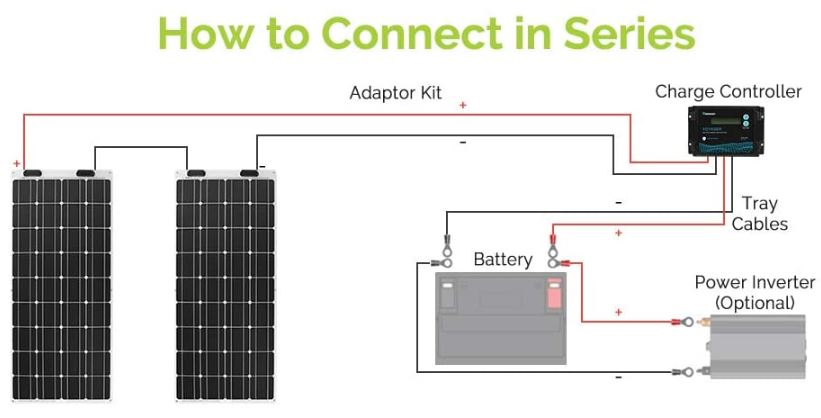
What’s So Special About Monocrystalline Panels?
So, what does “monocrystalline” mean? And why is it a feature we should be looking at? The answer is that solar cells are constructed from a silicone crystal. As you know, the edges of a crystal distort and reflect light. On an engagement ring, this creates a beautiful glittering effect. But on a solar panel, all that reflected light is escaping from the panel instead of generating electricity. As a result, the fewer edges to the crystal, the more efficient the panel.
There are two main types of solar panel: polycrystalline and monocrystalline. Polycrystalline panels use multiple silicone crystals, while monocrystalline panels use a single crystal. Because larger crystals are more expensive, polycrystalline panels are cheaper. In years past, this made them well worth considering. After all, twenty years ago, solar panels could cost thousands of dollars apiece! But with modern manufacturing techniques, the costs have come down by an order of magnitude. These days, a monocrystalline panel is going to get you more bang for your buck. You’ll get 30 percent more efficiency for just a few extra dollars.
Is 12 Volts Enough?
Another thing we need to talk about is the voltage. There are two reasons a 12-volt solar panel is a better choice than higher voltages. The first is the batteries most people use. The vast majority of consumer-grade batteries are 12 volts, both for off-grid and RV use. So by using a 12-volt panel, there won’t be any difference in voltage. You can seamlessly switch from solar panel power to battery power without using an inverter.
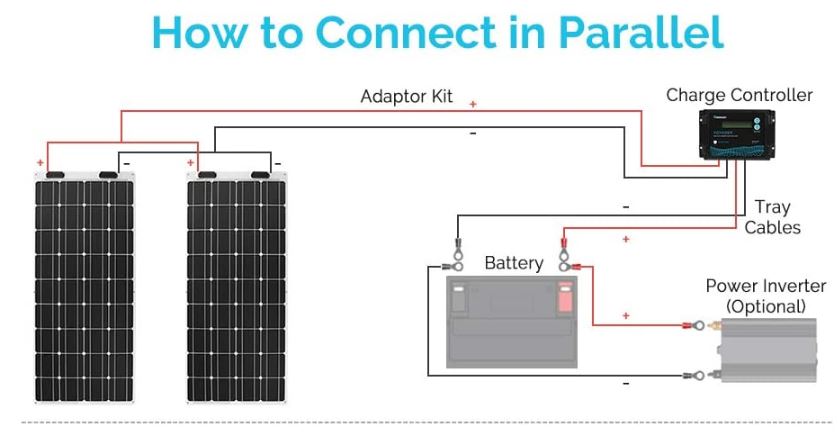
The next reason is scalability. With 12-volt panels, you have more installation options. You can wire your solar panels in parallel for a 12-volt system. You can pair two panels in series and wire them in parallel with other two-panel sets for a 24-volt system. Wire sets of three, and you’ll get 36 volts, and so on. So if you want to upscale to a higher-voltage system, it’s not a problem.
There is one case where you might want to use a higher-voltage panel. If you’re using a maximum power point tracker (MPPT), higher voltages can improve your system’s performance. But these systems are generally used for commercial applications, not for off-grid consumer use. Unless you’re running a very large solar array for commercial use, 12-volt panels will provide the best performance. Now that we know what we’re looking at, let’s check out the solar panels!
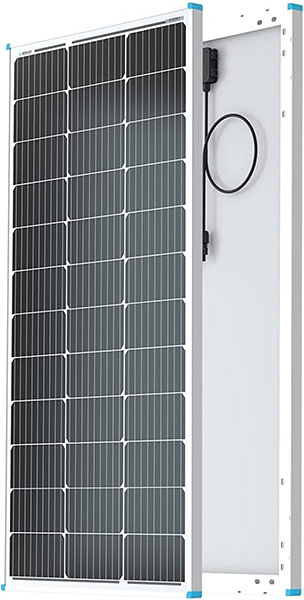
Renogy 100 Watt 12 Volt Monocrystalline Solar Panel
The Renogy 100 Watt 12 Volt Monocrystalline Solar Panel is built primarily for durability. The top of the panel is constructed from an anti-reflective, high transparency tempered glass. It’s exceptionally tough, and can withstand impacts that would break most other solar panels. Each panel measures 40.9 inches high, 21 inches wide, and 1.4 inches thick, and weighs 15 pounds.
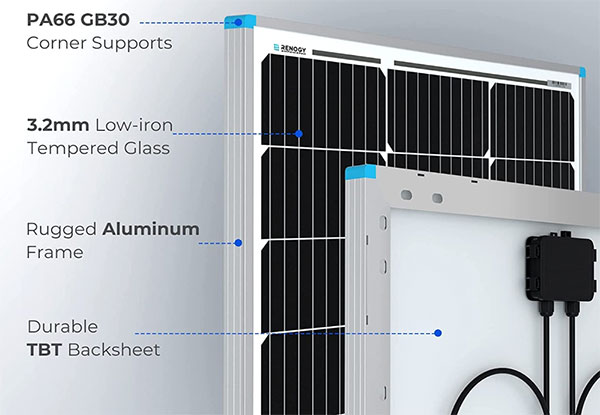
The frame is also exceptionally sturdy. It’s constructed from rugged black anodized aluminum, and can withstand winds of up to 2,400 Pascals. That’s equivalent to a 136 mile per hour storm! In other words, unless your solar panel gets hit by a tornado, wind is not going to be a problem. Moreover, the panels can withstand a snow load of 5,400 Pascals. How much snow that equates to will depend on the density of the snow. But suffice it to say, it’s a whole lot of snow! Not only that, but the junction box on the back is IP65 weather-resistant. And the MC4 connectors are IP67-resistant.
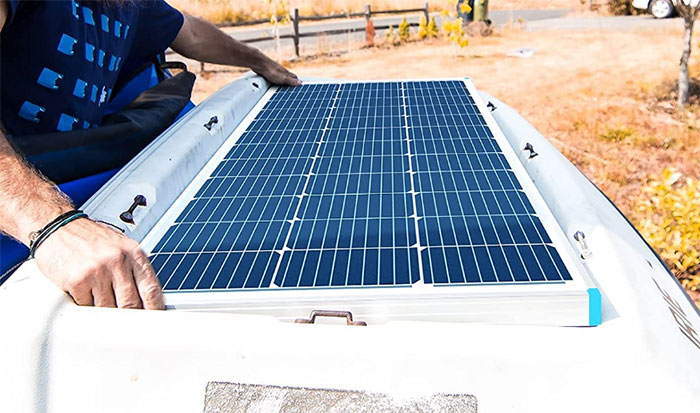
The black frame and solar cells have no unsightly grid lines. The panel actually looks pretty sharp when it’s sitting in your front yard! The cells themselves are coated with multi-layered laminated sheets, which maximize durability beneath the tempered glass. In addition, it helps distribute heat evenly across the entire panel. This ensures that you won’t get any hot spots that impact your panel’s performance. Between the individual cells, the copper connectors are exceptionally thick. These connectors ensure a stable connection, even with constant temperature fluctuations.
On the back, you’ll find a set of pre-drilled holes for mounting. You can attach it to a ground mount or a roof mount without any issues. And if you have a different type of mount, you’re still good to go. It’s compatible with Z-brackets, pole mounts, and tilt mounts in addition to fixed ground mounts. And with an efficiency of 22 to 24 percent, you’ll get plenty of bang for your buck.
Newpowa 100 Watt Monocrystalline 12v Solar Panel
The Newpowa 100 Watt Monocrystalline 12v Solar Panel is similar in many ways to the Renogy panel we just reviewed. It’s a similar size, measuring 44.49 inches tall, 19.88 inches wide, and 1.18 inches thick. It’s also a similar weight, tipping the scales at 16 pounds. That said, there are also some noticeable differences. First off, the frame is just a plain anodized aluminum, without the sharp black finish. There are also visible grid lines, which makes it a bit ugly. On the other hand, at less than half the price, cosmetics are less of a concern than function.
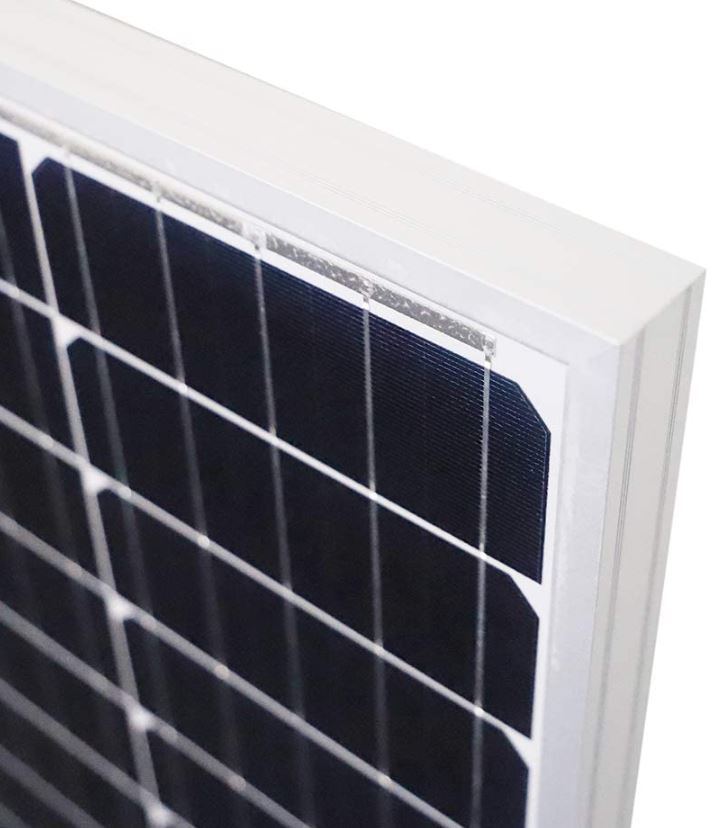
The cells themselves are enclosed in an EVA sheet that protects them from damage. This EVA sheet is in turn protected by a sheet of low iron tempered glass. The TPT backing is also quite durable, providing protection from the rear of the panel. The wind rating is comparable to the Renogy panel, at 2,400 Pascals. And the snow load rating is also comparable at 5,400 Pascals. However, there’s an important difference when it comes to water resistance. The edges of the Newpowa panel are not well sealed, and will admit water. To avoid this problem, Newpowa recommends sealing the edges with silicone glue during installation.
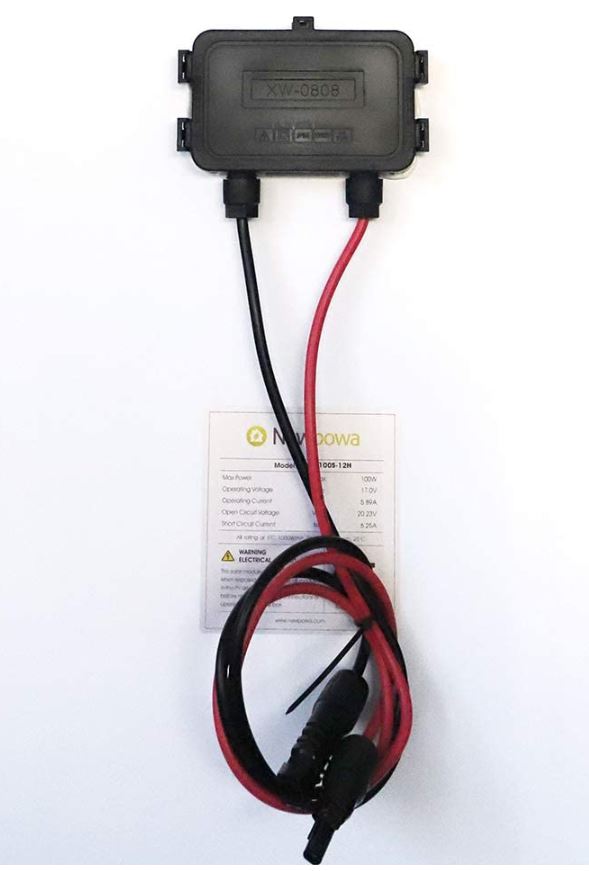
The Newpowa solar panel is compatible with most solar panel systems. It uses standard MC4 connectors that are easy to connect. Make sure to treat these with silicone as well, though, since they’re not water-resistant. There are also four pre-drilled holes on the back of the frame, so installation is a snap. Screw them into a standard four-point mount, and you’re good to go. When installed as recommended, Newpowa provides a 25-year power output warranty. Even better, this warranty is transferable. So if you sell your house, it’s a great added value for the new owner.
Renogy 100 Watt 12 Volt Extremely Flexible Monocrystalline Solar Panel
The Renogy 100 Watt 12 Volt Extremely Flexible Monocrystalline Solar Panel is very different from the last two panels. Instead of a rigid design, it’s flexible. And the word “extremely” in the name is not just marketing hyperbole. The panel can be flexed up to 248 degrees, or more than two thirds of a circle. This makes it very well designed for mounting on uneven surfaces. Attach it to a curved roof, an RV roof, or even a boat. Pretty much anywhere you need power, you can attach it. Installation is easy. Renogy recommends using silicone structural adhesive for attaching it. For an even sturdier attachment, there are also six mounting holes with metal grommets. If the situation warrants it, screw it down.
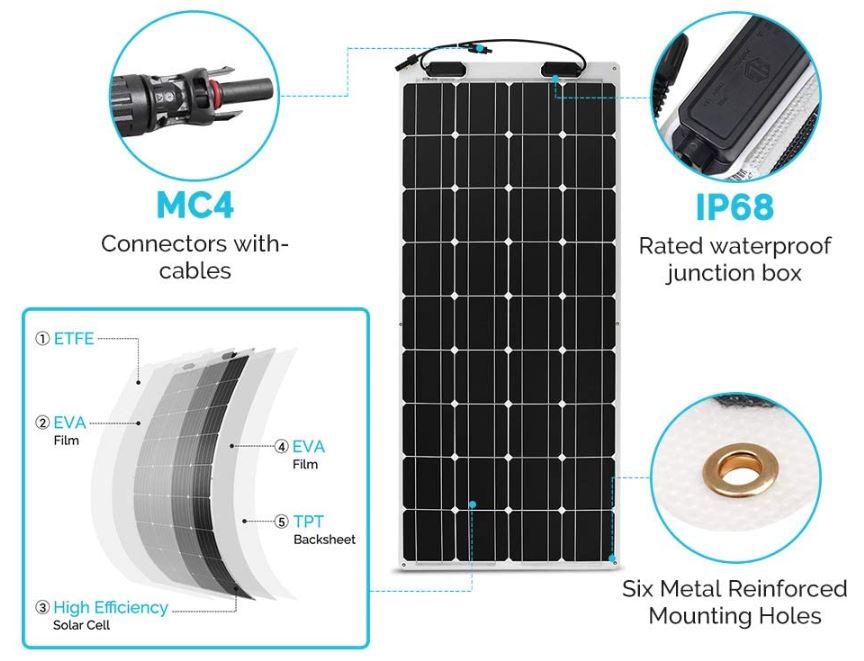
The panel measures 47.9 inches long, 21 inches wide, and 0.08 inches thick. This slim design and the advanced polymer construction are what allow it to be so flexible. It’s also exceptionally lightweight, at only four pounds. Even so, it can withstand 2,400 Pascal winds and up to 5,400 Pascals of snow pressure. Not only that, but the junction box has a water-resistance rating of IP68. This rating indicates that it’s able to withstand full submersion. Once again, we’re thinking about boats, and clearly Renogy was as well when they designed the panel. And if you’re building it into an existing system, you won’t have any issues. The connectors are a standard MC4 variety, which means they’ll work with just about any existing setup.
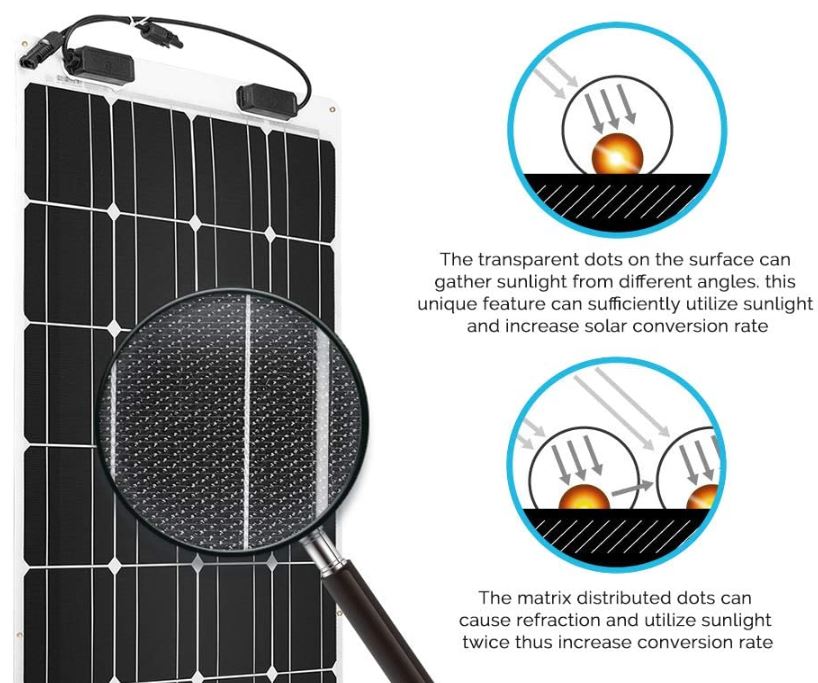
The only potential downside to a “flexible” solar panel is that it doesn’t cool off quite as well as a rigid panel. This will decrease the efficiency and life expectancy versus a standard rigid solar panel. Keep this in mind.
Final Verdict
So, which one of these solar panels is the right choice for you? It’s going to depend on your system, your needs, and how exactly you’re using the panel. Let’s do a quick roundup of what we’ve learned.
The Renogy 100 Watt 12 Volt Monocrystalline Solar Panel is the most weather-resistant of the bunch. If you’re looking for a panel that you can install and forget about it, you’re looking at a solid choice. With all water-resistant parts, moisture is simply not a concern. That said, the price point is a bit high. But considering what you’re getting for your money, it’s still a great value. Not only that, but it looks pretty sharp.
The Newpowa 100 Watt Monocrystalline 12v Solar Panel is a more affordable option. It’s still relatively sturdy, complete with tempered glass and a rugged aluminum frame. To be fair, it’s a bit ugly. Moreover, you’ll have to perform your own waterproofing during the installation. On the other hand, you also get Newpowa’s 25-year transferrable power guarantee. Not too shabby!
The Renogy 100 Watt 12 Volt Extremely Flexible Monocrystalline Solar Panel is a different beast altogether. It’s not designed to be part of a home or off-grid array. Instead, it’s designed primarily for use on RVs and boats. With its flexible engineering, you can mount it just about anywhere. Even so, it’s exceptionally durable, regardless of your application. And with an IP68 rating, you don’t have to worry about the elements. If you need a solar panel for an unorthodox application, it’s an excellent choice. However, do be aware that flexible panels are not quite as efficient and long-lasting as a stiff, rigid panel.
Meet Ry, “TechGuru,” a 36-year-old technology enthusiast with a deep passion for tech innovations. With extensive experience, he specializes in gaming hardware and software, and has expertise in gadgets, custom PCs, and audio.
Besides writing about tech and reviewing new products, he enjoys traveling, hiking, and photography. Committed to keeping up with the latest industry trends, he aims to guide readers in making informed tech decisions.

